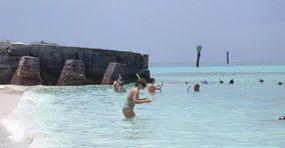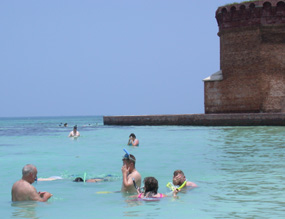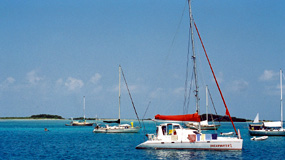
Pristine water offers ideal snorkeling, diving
DRY TORTUGAS, Fla.— The Florida Keys have long been known for offering vacationers a chance to escape the blazing hot sun– often high in a picturesque blue sky– by cooling off in the clear, sparkling water.
For snorkelers, South Florida’s ideal climate and natural beauty is a dream come true— a warm and deep blue sea, schools of exotically striped and speckled marine life, a rainbow labyrinth of centuries-old coral formations.
In many cases, it’s all just a matter of taking a short boat-trip to the middle of the Atlantic, where divers can hop off the back of a catamaran and enjoy an incredible, yet often time-restrained, aquatic experience.
The Dry Tortugas National Park, however, in addition to its historical significance, offers snorkelers a unique opportunity that they won’t find in Key West or Miami Beach.
“You know what’s so good about it?” asked Rick Gauron, captain of the Yankee Freedom II, a catamaran that offers daily shuttles covering the 68 miles between Key West’s Historic Seaport and the national park.
 |
Visitors take advantage of warm and shallow water to explore the coral reefs near Fort Jefferson (Staff photos). |
“A lot of people come down to the Keys and they don’t know what the snorkeling is. They come down with their family and the kids are intimidated because they didn’t realize that that you go five-and-a-half miles out to a reef, and then you jump off into the deep water.”
Water-loving visitors to the Dry Tortugas needn’t worry about treacherous waters or deep-sea dwelling predators. Rest assured, however, they will still be treated to the numerous underwater attractions that make the Keys such a popular vacation spot.
Literally just a few feet from the island’s secluded beaches, snorkelers can explore an underwater realm filled with brightly colored coral formations, conch shells and even the endangered sea turtles for which the island has been aptly named.
“This is the best snorkeling that I’ve ever done,” said Lynn Kavanaugh, 43, of Palm Harbor, Fla., who makes a yearly trip to the island with her longtime boyfriend and two sons. “I love the idea that it’s not in the middle of the ocean and the waves aren’t knocking you all over the place.”
Although snorkelers may actually swim around the entirety of Fort Jefferson’s outer moat wall, the best snorkeling is concentrated in two designated, marked-off swimming areas. The first, located near the currently closed campgrounds, is the relatively shallow waters along a roughly 100-yard stretch of white sands.
 |
A man walks the beach outside Fort Jefferson. |
Only a few feet deep in some spots, the water’s clarity allows snorkelers to get an intimate look at schools of tropical fish, brain coral and the seagrass beds which form a nursery for the area’s smaller marine life.
In fact, it is so shallow in some areas that swimmers are forced to restrain movement and simply float as they observe so as not to make contact with the coral formations, which can be destroyed if they are touched.
“It was great,” said Linda Kelly, 41, who visited the park with her family from Clearwater, Fla.
“We definitely wanted to go in the water, to go snorkeling and to see all the wildlife. The reefs had a lot of interesting animals and the corals are absolutely beautiful.”
 |
Park visitors dive near the fort. |
Added her husband, Sean, 45: “The water isn’t very deep here at all, and that definitely has its charm.”
On the opposite side of the island, a second, smaller stretch of beach offers visitors another opportunity to get up close and personal with a variety of oceanic wonders.
Literally in the shadow of the fort, a kaleidoscopic coral formation stretches alongside Jefferson’s moat wall, and the deeper waters– with their varying shades of aquatic blue, turquoise, and light green– attract a bevy of larger underwater creatures.
“We’ve seen some parrotfish, some lobsters, and the biggest manta ray I’ve ever seen,” said Eileen Sullivan, 45, of Orlando, who said that she and son John, 8, opted for the tranquility of the Dry Tortugas over the often-crowded South Florida alternatives.
 |
Swimmers and snorkelers near the fort. |
“This is definitely more relaxing. With the coral reef [in deeper waters], sometimes you’ll see a lot more fish and the visibility is a bit better, but I definitely went for this.
” I didn’t want to go out with 50 people and ‘swim in a roped-off sea,’ as Jimmy Buffett would say.”
The water can get up to about 15 feet deep along the side of the moat walls and around the North coaling dock ruins. On a clear summer day, water temperatures can reach the mid-80s, and visibility is often clear enough to see even the smallest creatures scouring the ocean floor.
“I’d say snorkeling is the most popular attraction in the summertime,” said Gauron, who has traveled to the island four times a week since becoming captain of the Yankee Freedom in 1998.
“There’s the clarity of the water, and a lot of people who may be interested in the fort just can’t deal with the heat. This snorkeling is leisure and there are a lot of good things to see.
 |
Boats at anchor near Fort Jefferson. |
” You can still be safe and close to shore, and that’s what I find a lot of people say is really neat— to be able to do it from the beach, and still have that real good snorkeling. They come down just because they’ve heard about this beach and that the snorkeling is so great.”
Whether coming to the island specifically for its tranquil beaches and a chance to snorkel in relative isolation, or to explore the ruins of Fort Jefferson, most visitors can’t help but take at least a brief dip in the Tortugas’ refreshing, clear water.
“As far as a family outing, this is a great time to spend together,” said Rodney Landry, 44, of Anchorage, who enjoyed the snorkeling with wife, Caroline, 39, and son, Zachary, 15.
“You’re secluded on the island and you get to just be around each other. It’s 100 percent better than Key West, Miami, or any of the beaches. Here, you can do your own thing,” he added.
If You Go
You can get to the Dry Tortugas National Park via ferry boat, which leaves from Key West’s Historic Seaport, or by seaplane, which leaves from Key West International Airport.
Both the ferry and seaplane companies provide passengers with snorkeling fins and masks. However, fins and masks are all they provide. If you do plan on spending time on Fort Jefferson’s beaches, bring all your own beach necessities, including sun block, towels and/or beach blankets.
Tip: As is expected, the island is short on shade. Those who are prone to sunburns or who wish to limit their exposure to the sun should be sure to bring a powerful sun block, and possibly extra clothing and accessories (such as hats or beach umbrellas) to avoid a painful return to Key West.
Although Dry Tortugas shuttle services provide lunch for passengers, visitors may bring their own food or drink to the park in coolers or other containers. Food and drinks are not permitted on the beach itself, but they are allowed in the designated camp areas (directly behind the beach and near the island’s main docking area).

Comments are Closed